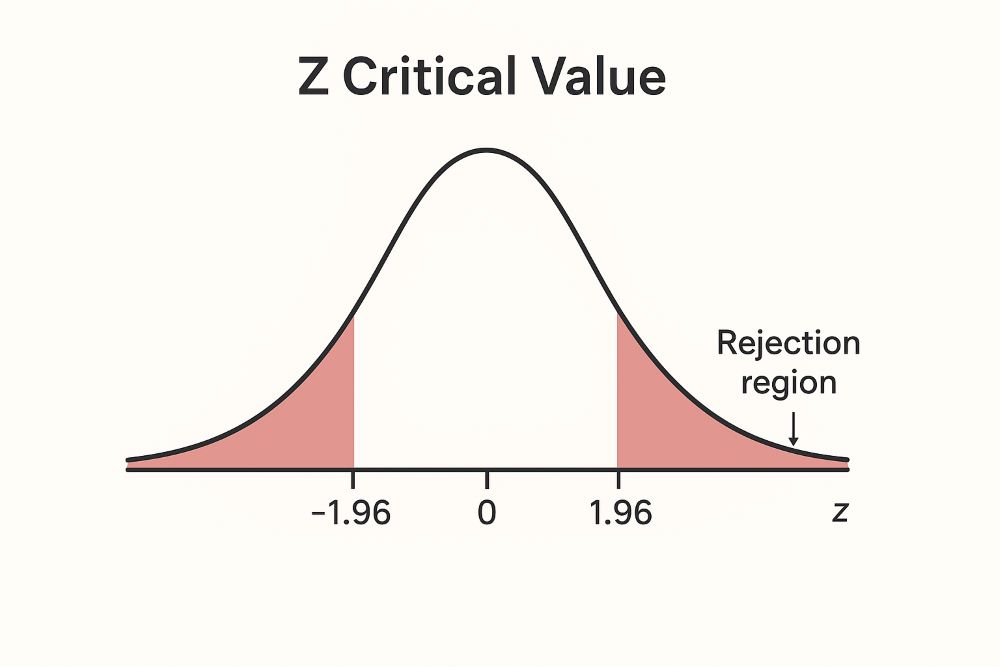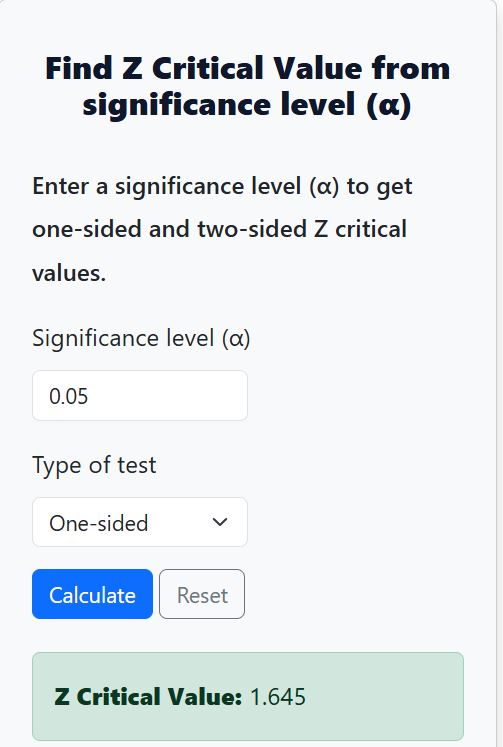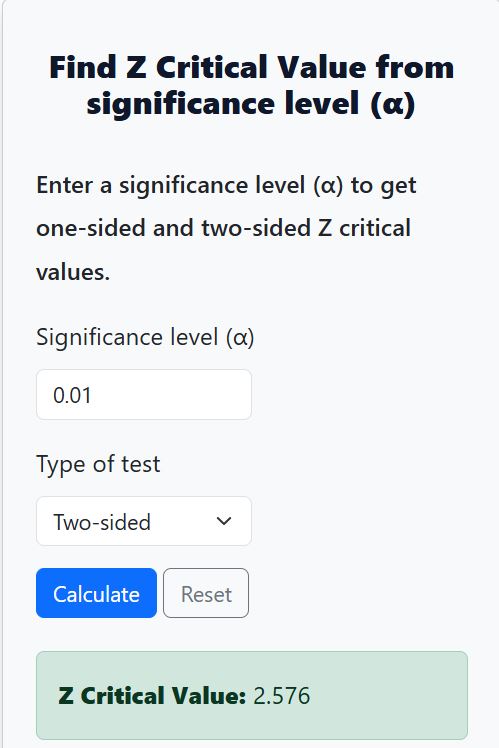Z Critical Value Calculator [One-sided & Two-Sided Tests]
The Z Critical Value Calculator is a simple online tool that helps you find z critical values quickly and accurately. It is designed to compute both one-tailed and two-tailed z critical values for any significance level, also called alpha. Instead of using long statistical tables, you can get results in just a few clicks. In addition, the calculator provides a clear step-by-step solution that shows how each value is calculated. This makes it easy to understand the process and learn while solving problems. Whether you are a student, researcher, or data analyst, the calculator saves time and ensures accuracy in hypothesis testing and confidence interval calculations.
Find Z Critical Value from significance level (α)
Enter a significance level (α) to get one-sided and two-sided Z critical values.
What is a Z Critical Value?
A z critical value is a point on the standard normal distribution that separates the rejection region from the acceptance region. In simple terms, it gives the cut-off value beyond which results count as statistically significant. During a hypothesis test, you compare the computed z test statistic with the z critical value to decide whether to reject the null hypothesis. You also use z critical values when calculating confidence intervals for the mean, especially when the population standard deviation is known. By setting this clear threshold, z critical values play a central role in statistical decision-making.
The standard normal distribution is a bell-shaped curve with a mean of zero and a standard deviation of one. Each z critical value corresponds to a probability, or alpha level, which shows the risk of making a Type I error. For example, at a 5% significance level in a two-tailed test, the cutoff is ±1.96. The figure below shows this threshold on the curve, with the shaded rejection regions.

How to Use the Z Critical Value Calculator
Using our Z Critical Value Calculator is quick and easy. Follow these steps to find your z critical value:
- Enter the significance level (alpha) such as 0.05 for a 95% confidence level.
- Choose between a one-sided or two-sided test depending on your hypothesis.
- Click the “Calculate” button, and the tool will instantly compute the z score corresponding to the alpha (level of significance).
The calculator will show you the z critical value along with a step-by-step solution.
Z Critical Value Formula
The z critical value formula is defined as follows:
$$Z_{\alpha} = \Phi^{-1}(1 – \alpha)$$
Where:
- $\Phi^{-1}$ is the inverse of the cumulative distribution function (CDF) of the standard normal distribution. In other words, it is the function that tells us the z score that corresponds to a given probability
- α is the significance level. It represents the probability of rejecting the null hypothesis when it is actually true.
Therefore, for a one-tailed test, the entire alpha level is placed in a single tail of the distribution. This means you directly apply the formula without changing the α. However, for a two-tailed test, the alpha level is divided equally between the two tails. In this case, you replace α in the formula with α/2, since each side of the distribution contains half of the rejection area.
How to Compute Z Critical Value: Worked Examples
Finding a z critical value becomes simple once you understand the formula. You can calculate it by hand using the inverse of the cumulative distribution function, or you can look up the inverse values in standard normal tables (positive and negative). To save time and avoid errors, you can also use the Z Critical Value Calculator, which shows each step clearly. Below are examples that connect the manual computation process with the calculator results.
Example 1: Find a one-tailed z critical value corresponsing to α = 0.05
Solution
1. By definition, the z critical value formula is:
$$Z_{\alpha} = \Phi^{-1}(1 – \alpha)$$
2. Compute 1−α
=1-0.05
=0.95
3. Find $\Phi^{-1} (0.95)$
From the standard normal table and looking for the z value corresponding to p =0.95, the z score is 1.645.
Thus, the one-tailded (sided) Z critical value corresponding to α = 0.05 is 1.645.
Alternatively, using the calculator, you simply insert the significance level (α = 0.05) and select one-sided as the type of test. On hitting the “Calculate” button, you’ll get instant results as shown below:

Example 2: Find the two-tailed z critical value corresponding to α = 0.01
Solution
1. By definition, the z critical value formula is:
$$Z_{\alpha} = \Phi^{-1}(1 – \alpha/2)$$
2. Since this is a two-tailed test, split α into two equal parts:
α/2=0.01/2
=0.005
3. Compute 1−α/2
= 1−0.005
=0.995
4. From the standard normal table, the z value corresponding to p=0.995 is 2.576.
Thus, the two-tailed z critical values corresponding to α = 0.01 are: Z=±2.576
Alternatively, using the calculator, you simply insert the significance level (α = 0.01) and select two-sided as the type of test. On hitting the “Calculate” button, you’ll instantly get the results, with both steps and values clearly displayed.

Z Critical Values for Common Significance Levels
While the calculator can give you exact results for any alpha level, it is also helpful to have a quick reference. The table below shows the most widely used one-tailed and two-tailed z critical values at common significance levels.
| Significance Level (α) | Confidence Level | One-Tailed Z Critical Value | Two-Tailed Z Critical Value |
|---|---|---|---|
| 0.10 | 90% | 1.282 | ±1.645 |
| 0.05 | 95% | 1.645 | ±1.960 |
| 0.025 | 97.5% | 1.960 | ±2.241 |
| 0.01 | 99% | 2.326 | ±2.576 |
| 0.005 | 99.5% | 2.576 | ±2.807 |
| 0.001 | 99.9% | 3.090 | ±3.291 |
Conclusion
The Z Critical Value Calculator makes it easy to find the exact cutoff points needed for hypothesis testing without the hassle of statistical tables. By showing both one-tailed and two-tailed values with step-by-step solutions, it helps you understand not just the results but also the reasoning behind them. This clear link between the formula, worked examples, and calculator output ensures that learning and application go hand in hand. Whether you are checking significance levels for research or building confidence intervals, the calculator saves time and reduces errors while strengthening your grasp of statistics.
Frequently Asked Questions
A z critical value is a cutoff point on the standard normal distribution that defines the rejection region in hypothesis testing. It helps decide whether to reject or accept the null hypothesis.
The calculator uses the inverse of the cumulative distribution function of the standard normal distribution. You enter the significance level (alpha) and select one-tailed or two-tailed. The calculator then computes the correct z critical value and shows the step-by-step solution.
For a two-tailed test at 95% confidence (α = 0.05), the z critical values are ±1.96. You can verify this instantly with the calculator by setting α = 0.05 and choosing a two-sided test.
In a one-tailed test, the entire significance level (α) is placed in one tail, so the cutoff is in one direction only. In a two-tailed test, α is split equally into both tails, so the cutoff points are on both sides of the distribution. The calculator allows you to choose either option.
A z score represents the position of a data point relative to the mean in standard deviation units. A z critical value, on the other hand, is the threshold used in hypothesis testing to determine whether a result is statistically significant.
You use z critical values when the population standard deviation is known and the sample size is large (usually n > 30). T critical values are used for smaller samples or when the population standard deviation is unknown.
